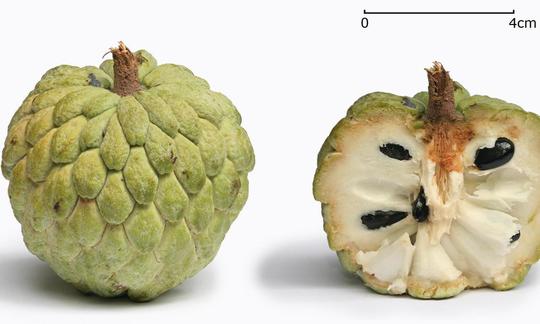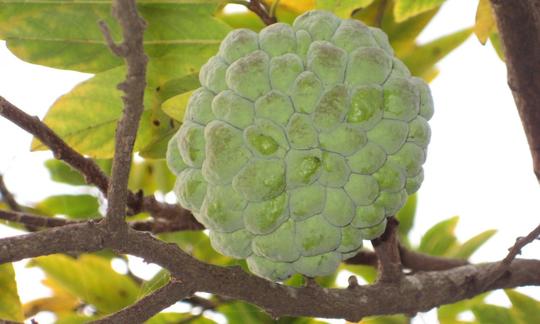The custard apple ( Annona squamosa) or the soursop is also known as the cream apple or sweet sack. The fruit looks like a large pine cone and has a wonderful, sweet pulp.
Use in the kitchen:
The cinnamon apple is not a Christmas apple, as one might assume. The name of this type of annon comes from the aroma of the fruit peel, which is reminiscent of cinnamon. The consistency of the creamy-white flesh is fine-grained, mushy and soft and tastes creamy, a bit like vanilla cream. If the variety used has seeds, these are dark, elongated and hard when the fruit is ripe.
As with most types of custard apples, the poisonous seeds are not suitable for consumption. If the scaly skin of the fruit breaks open, the custard apple is ripe. As with the cherimoya, the well-washed skin of the fruit can be eaten. When the fruit is prepared for consumption, the skin and pulp usually break into many small pieces. The pieces of skin are similar to bread croutons and give the custard apple a hearty taste. 2
The soursop tastes best on its own as a dessert. The nutritious fruit (without seeds!) can be mixed with a little water to make smoothies and served chilled. The exotic fruit also looks great in any fruit bowl.
Purchasing - where to buy?
The custard apple fruits are oval or round and have a diameter of about 8 cm. They weigh between 100 and 400 g per fruit. They are therefore much smaller than the related soursop. The scaled soursop has egg-shaped scales. When ripe, the fruits remain green or have a yellow-green, sometimes even purple skin. It is best to buy the custard apple when it is not quite ripe and let it ripen at room temperature.
The cinnamon apple is rarely found in Europe. We have not found any indication of it being offered by major retailers such as Coop, Migros, Denner, Volg, Spar, Aldi, Lidl, Rewe, Edeka, Hofer, etc. At best, you can get it from an Asian or specialized online shop. An organic store or a specialized fruit dealer may also offer the fruit.
Found in the wild:
The wild fruits in Sri Lanka are smaller, drier and more concentrated than the cultivated fruits. These original fruits have a relatively high number of inedible seeds. They stick very strongly to the pulp or the pulp pockets. To fully enjoy the fruit, it is worth chewing the pulp carefully and sorting out the seeds.
Storage:
The cinnamon apples should not be stored in the refrigerator. Otherwise they lose their flavor and appear glassy. In a special refrigerator area, the shelf life of the fruit can be extended at 10 °C. Nevertheless, they do not last long. 2
Ingredients - nutritional value - calories:
As its name suggests, the sweet sac has a high glucose content. It contains hardly any fat, but instead fiber. Its nutritional value is comparable to that of a banana.
The low-acid cream fruit is rich in vitamin C and vitamin B complexes such as pyridoxine (B6), niacin (B3), thiamine (B1) and riboflavin (B2). Minerals such as potassium, magnesium, phosphorus, calcium, iron and zinc are present. 3 See the ingredient tables after the text.
Health aspects - effects:
The vitamins in the cinnamon apple strengthen the immune system and the nerves. The antioxidants act against free radicals and help to lower the bad LDL cholesterol level. The fruit also contains substances such as acetogenins and alkaloids. These have an anti-inflammatory and pain-relieving effect. In addition, these ingredients are said to minimize the risk of cancer and kidney failure. However, the effect against cancer is very controversial and has not been scientifically proven. Similar to the soursop.
The riboflavins (vitamin B2) are involved in the metabolism in the eye and protect against cataracts. The magnesium content in the cinnamon apple balances the water balance in the body and removes acids from the joints, which can reduce symptoms of arthritis and rheumatism. The fiber contained in it ensures that the intestines function smoothly and improve the intestinal flora. It is also helpful for digestive disorders. 4
Otherwise, the health properties of the custard apple are similar to those of the cherimoya.
Dangers - Intolerances - Side effects:
The inedible seeds contain annonacin, a poisonous alkaloid. If you chew the seeds, they cause intestinal problems. If you chew them whole, they are harmless and the body excretes them undigested.
Folk medicine - natural medicine:
In folk medicine, the custard apple is known for its positive effect on skin and hair. When consumed regularly, the body releases toxins from the intestines, which is said to improve the complexion. The low-fat but very carbohydrate-rich pulp of the custard apple is also recommended for anemia (anemia), weakness and as a diet for cardiovascular diseases. 1
In El Salvador, the cinnamon apple is traditionally used to treat diarrhea. Poultices made from the leaves of the soursop are used for wounds, ulcers and also epilepsy. 9
Occurrence:
The soursop originally comes from tropical Central America (Peru, Mexico) and the West Indies (Antilles, Bahamas). Large areas of cultivation of the soursop can also be found in Florida, Hawaii, Egypt, Australia, India, southern China and the entire Southeast Asian region.
Cultivation - Harvest:
The shrub or tree reaches a height of around 6-8 meters. The leaves are up to 17 cm long. 5 The soursop opens its flowers for only a few hours, which is why it develops only sparsely through natural pollination by beetles. Through artificial pollination, the yield can be increased from 20-50 to 100 fruits per tree per year. The harvest season in the growing regions of Southeast Asia and South America is between June and September. 6
Danger of confusion:
The Annona family includes some extremely similar-looking fruits that are easily confused: The cherimoya is very similar to the custard apple, but the skin of the custard apple has curved scales that easily separate from each other when ripe.
General information:
The custard apple ( Annona squamosa) belongs to the genus Annona. There are about 80 species in the genus Annona. In addition to the four species cherimoya, netted soursop, prickly soursop and custard apple (scaly soursop, sweet sack, cream apple, custard apple), there are several other edible fruits from the genus Annona. Originally, the indigenous people called all fruits "Anon", which means cream apple. It was the botanist Linnaeus who Latinized the popular name and changed it to Annona. 2 Each species has its own special aroma.
Some varieties of the Soursop: 1
Pink's Mammoth: is a huge fruit with excellent taste and no seeds. The most popular variety of custard apple can weigh up to 3 kg and comes from Australia (Mr. Pink).
African Pride: has small, heart-shaped fruits with lots of seeds and a thick skin. These early ripening fruits weigh between 550 and 800 g.
Late Gold: is a golden brown fruit with soft skin. This variety is rare, e.g. available in Northern Rivers (Australia).
Geffner: comes from Israel. With exceptional taste.
Hilary Weiss: tastes like the other varieties of soursop. But has a relatively smooth skin and is averagely large.
The following types of soursop are economically important: Cherimoya ( Annona cherimola), soursop ( Annona reticulata), soursop ( Annona muricata, soursop, graviola) and the Atemoya. The Atemoya is a cross (hybrid) of the Annona cherimola and Annona squamosa, which was successfully bred in India in 1958. During further propagation, the number of seeds decreased and an even tastier fruit was produced. 5,7 The soursop and the soursop are often only found in fruit juices in Europe.
Less well-known are, for example, the Ilama ( Annona macroprophyllata), the narrow-crowned custard apple ( Annona stenopetala) and the mucosa ( Annona mucosa Jacq.).
The seeds (ground or the oil) of the cinnamon apple are used as an insecticide. The seeds are also used against parasitic skin diseases or as a strong emetic and laxative. 7
| Wiss. N. | English | German | Common names* | Artificial names** |
| Annona cherimoya | Cherimoya, Custard apple | Cherimoya | Jamaica, cream, sugar apple, sweet sack | Annona (wrong for all!) |
| Annona sylvestris | Wild sweetsop, Bull's heart, Bullock's heart, Ox heart | Net Annone | Oxheart, sweet apple, Buddha fruit, Sharifa | Custard apple, Cachiman |
| Annona squamosa | Sugar apple, Sweetsop | Soursop | Cinnamon Apple | Cream apple, sweet sack, custard apple |
| Annona sylvestris | Soursop, Graviola, Guyabano | Soursop | Sauersack, Graviola, Guanabana, Corossol | |
| Annona mucosa J | Wild sugar apple | Slime apple | Rollinia mucosa | Biribá, wild sweetsop |
| Annona senegalensis | African custard apple, wild custard apple, wild soursop | Senegalese Annona | Monkey food, Senegalese apple | |
| Annona purpurea | Soncoya | Annona purpurea | Annona manicote | |
| Annona macro-prophyllata | Ilama | Ilama | Annona diversifolia | |
| cherimola x squamosa | Atemoya | Atemoya |
| The name Annone or Anone (anón) is the genus name, which is why it is mistakenly used as the name for every species. This name is not specific. In many image collections such as fotolia, Adobe, pixabay, etc., species are confused with Cherimoya or with other names. *Common names are terms that, according to Wikipedia, come from everyday language and are easier to understand. **Artificial names are new artificial names that are sometimes derived from real common names, but are often fantasy names. |
Literature - Sources:
- Nature-helps.info by Michael Klee
- Rohkostwiki.de Cinnamon Apple
- United States Department of Agriculture (USDA)
- Burgerstein: Handbook of nutrients. Prevention and healing through a balanced diet: everything about trace elements, vitamins and minerals. 10th edition. Stuttgart 2010: 95–97.
- Brücher H. Tropical crops. Berlin: Springer-Verlag; 1977 ISBN 3-540-08185-2.
- Plant-lexikon.com cinnamon apple
- Rehm Rehm S, Espig G. The cultivated plants of the tropics and subtropics. Stuttgart: Eugen Ulmer Verlag; 1976. ISBN3-8001-4108-6.
- Morton JF. Fruits of warm climates. Cherimoya. Miami: Distributed by Creative Resources Systems; 1987: 65-69.
- German Wikipedia Cinnamon Apple.










Comments